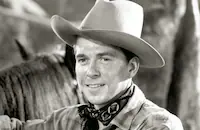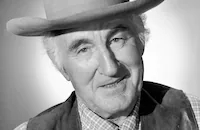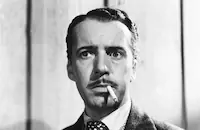Sergeant Murphy

Brief Synopsis
Cast & Crew
B. Reeves Eason
Ronald Reagan
Mary Maguire
Donald Crisp
Ben Hendricks
Max Hoffman Jr.
Film Details
Technical Specs

Synopsis
Private Dennis Reilly has followed his horse, Sergeant Murphy, into the army and when Murphy is transferred to the cavalry, Dennis transfers also. Because he wants the horse to be discharged from the army when his own enlistment is finished, Dennis coaches Murphy to act wild so he will not be considered a good cavalry horse. Col. Carruthers thinks Murphy has potential, however, and sends him back to school. Meeting the attractive Mary Lou Carruthers while he is exercising Murphy, Dennis tells her Murphy's story without realizing that she is the colonel's daughter. Now that she knows the truth, Mary Lou is able to take Murphy successfully through his paces. She offers to help Dennis buy Murphy from the army after he leaves, but when Murphy is injured on a jump, the colonel is forced to sell him sooner. Dennis is prohibited from owning the horse as long as he is in the army and the colonel refuses to postpone the auction until he is discharged. Dennis spends the last ten days of his enlistment in the guardhouse and as soon as he is released he obtains the address of Murphy's new owner, intending to buy him back at any price. He finds that Murphy was too wild for his new owners, who sold him in their turn. Finally he tracks Murphy to a dog food company and arrives just in time to save him from death. Dennis then enters Murphy in steeplechase races and wins regularly. He does so well that they sail to England to race in the Grand National, but when inspectors find ticks on the animals in the cargo of the boat, Murphy is placed in quarantine. Desperate, Dennis sneaks Murphy off the boat by forcing him to swim to shore. After a near miss, Murphy wins the race, and the colonel, who is attending with Mary Lou, is forced to wear her hat and ride Murphy to the winner's circle as a penalty for betting against him.

Director
B. Reeves Eason
Cast

Ronald Reagan
Mary Maguire

Donald Crisp
Ben Hendricks
Max Hoffman Jr.
Sergeant Murphy

Emmet Vogan
Tracey Lane
Edmund Cobb
Ellen Clancy

Rosella Towne
Helen Valkis
Sam Mcdaniels
David Newell

William Davidson

Edward Keane
Douglas Wood
Fred Miller

Walter Miller
Raymond Brown
John Dilson
Lee Prather
William Worthington
Jack Richardson

Boyd Irwin

Wilfred Lucas
Cyril Thornton
Alec Harford
Dave Thursby
John Graham Spacey
Reginald Sheffield
Henry Otho
Artie Ortego
Art Mix
Kansas Moehring
Chad Trower
Jack Shannon
Lloyd Lane
James D. Green
Jimmy Adamson
Crew
Cy Bartlett
Frank Beckwith
Abem Finkel
Bryan Foy
James Gibbon
William Jacobs
William Kissell
Charles Lang
Ted Mccord
Hugh Reticker
Carrol Sax
Howard Shoup
Jack L. Warner

Film Details
Technical Specs

Articles
Sergeant Murphy
The one-time sports announcer had made his debut with a starring role in the low budget Love Is on the Air (1937) and had hoped to move up at the studio. Instead, he was assigned to Sergeant Murphy, another B movie, after James Cagney had turned it down. Of course, there was nothing unusual about that. Like most studios, Warner Bros. used its B-movie unit as a training ground for young talent (and a dumping ground for temperamental stars like Cagney). Films like Sergeant Murphy gave the inexperienced young actor the seasoning he needed while also letting the studio - which hoped to groom him as a replacement for the late Ross Alexander who had specialized in similar roles before his death - ascertain whether any further investment in the actor would be worthwhile. Reagan would churn out nine films in 1938, most of them programmers. By the end of the year, he would begin moving to bigger films with his supporting role in the military comedy Brother Rat (1938).
Sergeant Murphy was produced, without credit, by Bryan Foy, the son of musical star Eddie Foy and head of the Warner's B unit. The story had come from writer Sy Bartlett, who would achieve greater fame after World War II as the author of the novel Twelve O'Clock High, a tale of wartime flyers that would inspire the 1949 Gregory Peck hit. Writer Abem Finkel, who helped with the story, would move into A films faster than Reagan. Later that year he would get the chance to write White Banners for Claude Rains and Fay Bainter and Jezebel for Bette Davis.
Confirming Sergeant Murphy's status as a Warners' B film was the presence of director B. Reeves Eason. Nicknamed "Breezy," Eason was known for his ability to shoot films that moved as quickly as they had been shot. He rarely did more than one take, even when actors flubbed lines. Eason actually worked on two of Hollywood's biggest films, Ben-Hur (1925) and Gone With the Wind (1939), but as a second-unit director. For the former, he directed the chariot race, using 42 cameras to capture the action. For the latter, he directed the burning of Atlanta, the first sequence actually put on film, shot before the role of Scarlett O'Hara had even been cast.
Working with Eason was hardly the career Reagan had hoped for, but at least he could console himself by romancing co-star Mary Maguire off-screen. The Australian beauty had debuted in her native country at the age of 16 in the historical epic Heritage (1935). A co-starring role opposite Charles Farrell in the international production The Flying Doctor (1936) brought her a Warner's contract, but the studio confined her to B movies for her few years there. In 1938 she relocated to England, where she continued in film until her retirement, ironically after making the Warner Bros. British production This Was Paris (1942).
Also cast in Sergeant Murphy was Donald Crisp as Reagan's hardnosed commanding officer and Maguire's father. A screen veteran, both as actor and director, Crisp had started in silent films, most notably with D.W. Griffith, who cast him as Ulysses S. Grant in The Birth of a Nation (1915) and Lillian Gish's abusive father in Broken Blossoms (1919). Although he reached the height of on-screen fame with his Oscar®-winning role in John Ford's How Green Was My Valley (1941), he was better known off-screen for his business interests, including service on the Bank of America's advisory board. In that capacity, he was instrumental in securing financing for several major Hollywood features of the'30s and '40s. By the '50s, he was one of the wealthiest actors in Hollywood.
Despite his misgivings about films like Sergeant Murphy, Reagan was clearly on the rise at Warner Bros. Dick Powell, who feared that Reagan would soon supplant him as the studio's reigning juvenile, was already eyeing him suspiciously. Although they would become friends and political allies later in life, Powell was one of the few co-stars from Reagan's early Hollywood years who didn't like the young actor. Powell's fears were well founded, as his own career was slumping by the late '30s, just as Reagan was proving his usefulness to the studio, first with B pictures like Sergeant Murphy, and then with strategically chosen roles in A pictures.
Producer: Bryan Foy (uncredited)
Director: B. Reeves Eason
Screenplay: William Jacobs, Abem Finkel (uncredited)
Based on a story by Sy Bartlett
Cinematography: Ted D. McCord
Art Direction: Hugh Reticker
Music: Howard Jackson
Cast: Ronald Reagan (Pvt. Dennis Reilley), Mary Maguire (Miss Mary Lou Carruthers), Donald Crisp (Col. Todd Carruthers), Robert Paige (Lt. Duncan, as David Newell), Rosella Towne (Alice Valentine), Sergeant Murphy (Himself).
BW-57m. Closed Captioning.
by Frank Miller

Sergeant Murphy
Ronald Reagan, 1911-2004 - TCM Remembers Ronald Reagan
Ronald Reagan, the actor turned elected official whose fascinating career saw him develop as a contract player for Warner Brothers studios, to a politician who fulfilled his ambitions by becoming the 40th President of the United States, died at his home in Los Angeles on June 5 after a long battle with Alzheimer's disease. He was 93.
He was born Ronald Wilson Reagan on February 6, 1911 in Tampico, Illinois to John and Nelle Reagan. When Reagan was nine, his family settled down in the small community of Dixon, about 100 miles west of Chicago. After high school, Reagan enrolled in Eureka College, a small Christian school near Peoria. He graduated in 1932 with a degree in Economics, and pursued a career in broadcasting. His first gig was as a part-time announcer at WOC in Davenport, Iowa. Within a year, WOC had merged with its big-sister station, WHO in Des Moines, and Reagan was hired as a sports announcer.
In the spring of 1937, Reagan drove to Southern California to catch the Chicago Cubs in spring training on Santa Catalina Island. While he was in California, he wrangled a screen test and signed a contract for $200 a week with Warner Brothers. His film debut was rather inauspicious; he portrayed a radio announcer in an innocuous comedy Love is on the Air (1937). He made a few more "B" programmers like Hollywood Hotel (also 1937), and Girls on Probation (1938), before getting his first prominent role opposite Bette Davis in the popular tearjerker, Dark Victory (1939).
Although he seldom got credit for being a good actor, there was no denying that Reagan held his own given the right material: Knute Rockne, All American as the doomed Notre Dame football hero George "The Gipper" Gipp, where he delivered the film's immortal line "Win one for the Gipper!"; Santa Fe Trail in which he ably supports Errol Flynn in one of the boxoffice hits of its era (both 1940); Kings Row (1941), featuring one of his finest performances as a small-town playboy whose legs are amputated by a careless surgeon; and Desperate Journey (1942) where he again supported Flynn in an exciting action picture.
Due to his poor eyesight, Reagan didn't see any action in World War II, so the studio heads assigned him to star in a series of patriotic films produced by the First Motion Picture Unit of the Army Air Forces in Culver City. Between 1942-45, Reagan starred in over 400 of these films. After the war, Reagan still found some good roles: The Voice of the Turtle (1947) proved he had a deft hand at light comedy opposite Eleanor Parker; The Hasty Heart (1949) offered another underrated performance as he ably portrayed the Yank in John Patrick's much heralded wartime play; and Storm Warning (1950) was a slick melodrama that cast Reagan as a crusading District Attorney determined to bring the KKK in a small southern town, with the help of Doris Day and Ginger Rogers!
It was around this time that Reagan became involved in politics. In 1947, he began a five-year term as president of the Screen Actors Guild (SAG), and testified in October of that year before the newly formed House Un-American Activities Committee (HUAC). He identified suspected Communists Larry Parks, Howard Da Silva and Alexander Knox, all of whom were subsequently called to testify, and subsequently blacklisted. Later records showed Reagan was so concerned about the Communist influence in Hollywood, that he became an FBI informer.
As Reagan became steeped in his political career, his parts throughout the '50s became inferior: the notorious Bedtime for Bonzo (1951); the coy "sex" comedy She's Working Her Way Through College (1952) that cast him as a college professor who romances a stripper! (Virginia Mayo); Cattle Queen of Montana (1955), a sluggish Western that even the redoubtable Barbara Stanwyck couldn't save; and finally Hellcats of the Navy (1957), a stodgy war picture that would be his only film that co-starred his wife Nancy (Davis).
Television offered some salvation. For eight years, (1954-62), Reagan served as the host of General Electric Theater, a televised series of dramas. He also found a niche as GE's goodwill ambassador to employees and to civic and business groups around the country, furthering his taste and honing his craft as a public official. By the mid '60s, Reagan would move into politics entirely, save for one last film, the thrilling The Killers (1964), Reagan's only known villainous role, as a murderous gangster. That same year, he actively campaigned for Republican Presidential candidate Barry Goldwater, although Goldwater lost to Lyndon B. Johnson.
Reagan whose profile was riding high, had cemented his future as a successful politician. In 1966, he ran against incumbent Governor Pat Brown for the state of California and won, serving successfully for two terms until 1974.
Reagan began an all-out, two-year drive to wrest the 1976 nomination from incumbent Gerald R. Ford, an appointed vice president who became president on the resignation of Nixon. Reagan fell short by a handful of delegates to the Republican national convention. But Ford lost to Jimmy Carter, and Reagan became the front-runner to challenge Carter in 1980. After defeating Carter, Reagan held two terms as President of the United States (1981-89). After his second term was over, he retired quietly in California. In 1994, it was revealed to the media that Reagan was suffering from Alzheimer's disease; he had been kept out of the public eye since then.
He was married briefly to actress Jane Wyman (1940-48), and had two children; a daughter Maureen and an adopted son, Michael. In 1952, he married a budding film starlet, Nancy Davis, who bore him two more children; a daughter, Patty; and a son, Ronald Jr. Ronald Reagan is survived by Nancy, Michael, Patty and Ron Jr. His daughter Maureen died of Melanoma in 2001 at the age of 60.
by Michael T. Toole
Ronald Reagan, 1911-2004 - TCM Remembers Ronald Reagan
Quotes
Trivia
Notes
According to Variety, the Grand National races staged for the picture were filmed at Santa Anita Racetrack in California. Mary McGuire was an Australian actress making her American debut in this film. Modern sources indicate that this was based on a true story and that Ronald Reagan's role was offered to James Cagney who turned it down. Modern sources note that Reagan was a reserve officer in the Cavalry at the time the film was made.

Miscellaneous Notes
Released in United States Winter February 1, 1938
Second feature for actor Ronald Reagan.
Released in United States Winter February 1, 1938














